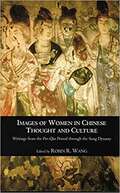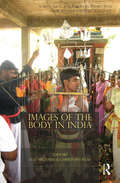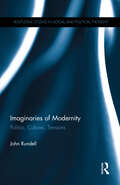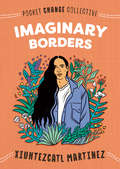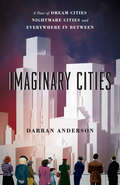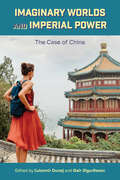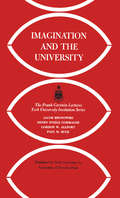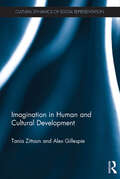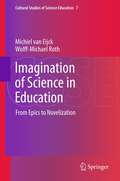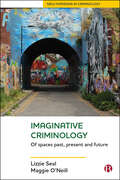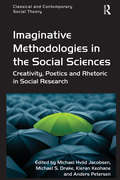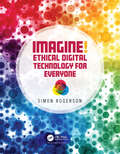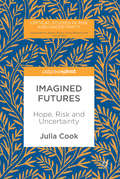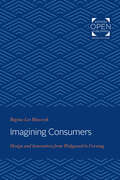- Table View
- List View
Images of Women in Chinese Thought and Culture: Writings from The Pre-Qin Period Through the Song Dynasty
by Robin WangThis rich collection of writings--many translated especially for this volume and some available in English for the first time--provides a journey through the history of Chinese culture, tracing the Chinese understanding of women as elucidated in writings spanning more than two thousand years. From the earliest oracle bone inscriptions of the Pre-Qin period through the poems and stories of the Song Dynasty, these works shed light on Chinese images of women and their roles in society in terms of such topics as human nature, cosmology, gender, and virtue.
Images of the American City
by Anselm L. StraussOriginally published in 1961, Images of the American City examines how Americans dealt with the rapid shock of urbanization as it evolved from an agricultural nation. Working from the framework of a social psychologist, Anselm L. Strauss offers a deeper look into the sociological, psychological, and historical perspectives of urban development. He describes how the cultural changes of a space ultimately develop urban imagery by looking towards the urbanization of America from peoples' views of the cities rather than how the cities are themselves. Urban imageries are contrasted with the context of an ideal city and visitors' perspectives of cities. Strauss takes a step back to ask questions about what Americans think and have thought of their cities. How do these cities compare to the image of an ideal city? What are the different perspectives between a city-dweller and a visitor? He contrasts the tension between those within the city and those outside of its urban limits. Strauss describes how space and time are major themes in the symbolic urbanization of a city. He offers a macroscopic view of the city as a whole and shows how urban imageries evolved from changes in lifestyles. He then provides historical breakdowns of different regions of the country and how they were urbanized. This book documents and illustrates the change in American symbolization from the growth of American cities to the union of urbanity and rurality.
Images of the Body in India: South Asian and European Perspectives on Rituals and Performativity
by Christoph Wulf Axel MichaelsThis intriguing book engages with the concept of the body in its cultural context by acknowledging and demonstrating that the human body is understood differently in Western and Indian cultures. The contributors go on to show that any attempt to put forward a single concept of the body within Indian culture would be misleading. Divided into three parts, the book examines the considerable and often conflicting variations in body images and body concepts. In Part One the contributors focus on the representation of the body in religious and philosophical texts; representations that emerged from reading, translating and interpreting classical writings from diverse historical and anthropological approaches. Through predominantly ethnographic studies, Part Two explores the role of the body in narratives and ritual performance, from dance to ritualistic ceremonies. Visualisation processes of the body are examined in Part Three, focusing on developments in modern and contemporary periods: from visual practices at the Mughal court, to the multiple bodies of the bride, and the influence of new media. This volume is a fascinating collection of articles for those in the fields of sociology and anthropology, history, religion, cultural studies and South Asian studies.
Imaginaries of Modernity: Politics, Cultures, Tensions (Routledge Studies in Social and Political Thought)
by John RundellThis book offers a new perspective on the issue of modernity through a series of interconnected essays. Drawing centrally on the works of Castoriadis, Luhmann, Heller and Lefort, and in critical discussion with Weber, Durkheim, Simmel, Adorno, Habermas and Taylor, the author argues that modernity is not only a unique historical creation but also a multiple one. With a focus on five broad themes - the problem of understanding of modernity after the decline of grand narratives; the complexity of the modern condition; politics, especially with reference to freedom and totalitarian regimes; the variety and density of modern life; and the centrality of a concept of culture to social and critical theory - John Rundell advances the view that modernity is not the outcome of an evolutionary process or historical development, but is unique and indeterminate, as are the constitutive dimensions that can be identified as 'modern'. There are, then, different modernities. A rigorous engagement with a range of prominent and contemporary social theorists, Imaginaries of Modernity casts new light on the significance of understanding the multidimensional character of modernity and the plurality of its forms beyond the conventional paradigms associated with only the West. As such, it will appeal to scholars of social theory, critical theory, sociology and philosophy concerned with questions of culture, politics and modernity.
Imaginary Borders (Pocket Change Collective)
by Xiuhtezcatl Martinez"It won't take you long to read this book, but it will linger in your heart and head for quite a while, and perhaps inspire you to join in the creative, blossoming movement to make this world work." -- Bill McKibben, environmentalist, New York Times bestselling author of The End of Nature, journalist, and founder of 350.org"An inspiring story that will change the way all of us think about the climate crisis - and how we can solve it." -- Van Jones, New York Times bestselling author of The Green Collar Economy and Rebuild the Dream, and co-founder of Dream Corps"A hopeful, well-argued book on climate change written in a refreshing new voice."-- Kirkus Reviews, starred review"Martinez presents a meaningful, heartfelt call to action with content that reflects current issues. Additionally, the book's short length will appeal to reluctant readers. An essential purchase for any high school or public library."-- School Library Journal, starred reviewIn this personal, moving essay, environmental activist and hip-hop artist Xiuhtezcatl Martinez uses his art and his activism to show that climate change is a human issue that can't be ignored.Pocket Change Collective is a series of small books with big ideas from today's leading activists and artists. In this installment, Earth Guardians Youth Director and hip-hop artist Xiuhtezcatl Martinez shows us how his music feeds his environmental activism and vice versa. Martinez visualizes a future that allows us to direct our anger, fear, and passion toward creating change. Because, at the end of the day, we all have a part to play.
Imaginary Cities: A Tour of Dream Cities, Nightmare Cities, and Everywhere in Between
by Darran AndersonFor as long as humans have gathered in cities, those cities have had their shining—or shadowy—counterparts. Imaginary cities, potential cities, future cities, perfect cities. It is as if the city itself, its inescapable gritty reality and elbow-to-elbow nature, demands we call into being some alternative, yearned-for better place. This book is about those cities. It’s neither a history of grand plans nor a literary exploration of the utopian impulse, but rather something different, hybrid, idiosyncratic. It’s a magpie’s book, full of characters and incidents and ideas drawn from cities real and imagined around the globe and throughout history. Thomas More’s allegorical island shares space with Soviet mega-planning; Marco Polo links up with James Joyce’s meticulously imagined Dublin; the medieval land of Cockaigne meets the hopeful future of Star Trek. With Darran Anderson as our guide, we find common themes and recurring dreams, tied to the seemingly ineluctable problems of our actual cities, of poverty and exclusion and waste and destruction. And that’s where Imaginary Cities becomes more than a mere—if ecstatically entertaining—intellectual exercise: for, as Anderson says, “If a city can be imagined into being, it can be re-imagined.” Every architect, philosopher, artist, writer, planner, or citizen who dreams up an imaginary city offers lessons for our real ones; harnessing those flights of hopeful fancy can help us improve the streets where we live. Though it shares DNA with books as disparate as Calvino’s Invisible Cities and Jane Jacobs’s Death and Life of Great American Cities, there’s no other book quite like Imaginary Cities. After reading it, you’ll walk the streets of your city—real or imagined—with fresh eyes.
Imaginary Worlds and Imperial Power: The Case of China
by Ľubomír Dunaj Geir SigurðssonNew and ambitious approaches to contemporary China, informed by perspectives taken from civilizational analysis and the specific concept of social imaginaries.This collection of essays by some of today's most prominent scholars on Chinese society, culture, and philosophy offers unusually comprehensive perspectives on contemporary China—a "broad way to China." Most of the essays are informed by the ambitious and erudite approaches of civilizational analysis developed in the theoretical and empirical lifework of Jóhann P. Árnason. Some authors explore China's long history and enduring philosophical and political traditions, revealing their continued influence on contemporary social imaginaries. Others critique the narrow limitations of most Euro-American views and discussions of China, highlighting how these can be an obstacle to a fruitful dialogue between China and "the West." Additionally, some essays present new perspectives on the potential value of Chinese social, political, and philosophical insights, suggesting they could inspire improvements in social, political, and philosophical dialogue within Euro-American cultures themselves.
Imagination and the University
by Henry Steele Commager Gordon W. Allport Jacob Bronowski Paul H. BuckThis volume, the Frank Gerstein Lectures for 1963, is the second series of Invitation Lectures to be delivered at York University. The theme "Imagination and the University" was appropriate for, as President Murray Ross states in this Foreword, it is in its early years that a university is sufficiently flexible to utilize imagination in its structure and in its curriculum. York University was in its third year when the Lectures were given.Four distinguished scholars present their views on the importance of an imaginative approach to the different academic disciplines, and to the conduct of life in contemporary society as a whole.Jacob Bronowski, speaking on Imagination in Art and Science, draws a clear and striking analogy between the role of imagination in mathematics and in poetry, drawing on his own experiences and contributions in both areas. He stresses that all creative works in art or science, must conform to the universal experience of mankind and to the private experiences of each man: the work of science, as of art, moves us profoundly, in mind and in emotion, when it matches our experience and at the same time points beyond it.Henry Steele Commager shows how important is the contribution to be made by an imaginative approach to politics, where, as in other fields of human experience, it must not be separated from reality, if it is to find expression in something more than words. He points to examples from the past and the present and asks for more imagination in public thinking, it fit our actions to the reality of change, citing the urgency of such twentieth-century phenomena as the status of Communist China, the predicted population explosion, and the threat of nuclear war. Professor Commager believes that the universities provide the key to this kind of approach, being a supreme example of the creative capacity of mankind, whose function it is to serve the commonwealth of learning.A different kind of insight is offered by Gordon W. Allport, whose subject is Imagination in Psychology. He believes that the present "impertinence" of psychology can best be cured by endowing it with more imagination. He demands a pluralistic approach to psychological investigation, which would not deny the insights yielded by traditional methods, with their characteristic minute analyses, but whose goal would be to fashion a conception of the human person that would exclude nothing that is valid, and at the same time preserve an ideal of rational consistency. This could lead, in turn, to a clear definition of the root motives of mankind, even to discovering new formulas for international peace by offsetting particularistic political demands. Finally, Paul H. Buck describes the Harvard House Plan as an example of Imagination and the Curriculum. This plan, modelled on the Oxford-Cambridge College system which is also followed in some Canadian universities, is an attempt to make all aspects of undergraduate life a process of education. And a truly liberal education for today and tomorrow, Professor Buck is confident, will combine a programme of general education, a programme of specialism, and a collegiate way of living.
Imagination in Human and Cultural Development (Cultural Dynamics of Social Representation)
by Tania Zittoun Alex GillespieThis book positions imagination as a central concept which increases the understanding of daily life, personal life choices, and the way in which culture and society changes. Case studies from micro instances of reverie and daydreaming, to utopian projects, are included and analysed. The theoretical focus is on imagination as a force free from immediate constraints, forming the basis of our individual and collective agency. In each chapter, the authors review and integrate a wide range of classic and contemporary literature culminating in the proposal of a sociocultural model of imagination. The book takes into account the triggers of imagination, the content of imagination, and the outcomes of imagination. At the heart of the model is the interplay between the individual and culture; an exploration of how the imagination, as something very personal and subjective, grows out of our shared culture, and how our shared culture can be transformed by acts of imagination. Imagination in Human and Cultural Development offers new perspectives on the study of psychological learning, change, innovation and creativity throughout the lifespan. The book will appeal to academics and scholars in the fields of psychology and the social sciences, especially those with an interest in development, social change, cultural psychology, imagination and creativity.
Imagination of Science in Education
by Wolff-Michael Roth Michiel Van EijckResearchers agree that schools construct a particular image of science, in which some characteristics are featured while others end up in oblivion. The result is that although most children are likely to be familiar with images of heroic scientists such as Einstein and Darwin, they rarely learn about the messy, day-to-day practice of science in which scientists are ordinary humans. Surprisingly, the process by which this imagination of science in education occurs has rarely been theorized. This is all the more remarkable since great thinkers tend to agree that the formation of images -- imagination -- is at the root of how human beings modify their material world. Hence this process in school science is fundamental to the way in which scientists, being the successful agents in/of science education, actually create their own scientific enterprise once they take up their professional life. One of the first to examine the topic, this book takes a theoretical approach to understanding the process of imagining science in education. The authors utilize a number of interpretive studies in both science and science education to describe and contrast two opposing forces in the imagination of science in education: epicization and novelization. Currently, they argue, the imagination of science in education is dominated by epicization, which provides an absolute past of scientific heroes and peak discoveries. This opens a distance between students and today's scientific enterprises, and contrasts sharply with the wider aim of science education to bring the actual world of science closer to students. To better understand how to reach this aim, the authors offer a detailed look at novelization, which is a continuous renewal of narratives that derives from dialogical interaction. The book brings together two hitherto separate fields of research in science education: psychologically informed research on students' images of science and semiotically informed research on images of science in textbooks. Drawing on a series of studies in which children participate in the imagination of science in and out of the classroom, the authors show how the process of novelization actually occurs in the practice of education and outline the various images of science this process ultimately yields.
Imaginative Criminology: Of Spaces Past, Present and Future (New Horizons in Criminology)
by Maggie O'Neill Lizzie SealThis distinctive and engaging book proposes an imaginative criminology, focusing on how spaces of transgression are lived, portrayed and imagined. These include spaces of control or confinement, including prison and borders, and spaces of resistance. Examples range from camps where asylum seekers and migrants are confined, to the exploration of deviant identities and the imagined spaces of surveillance and control in young adult fiction. Drawing on oral history, fictive portrayals, walking methodologies, and ethnographic and arts-based research, the book pays attention to issues of gender, sexuality, age, ethnicity, mobility and nationality as they intersect with lived and imagined space.
Imaginative Methodologies in the Social Sciences: Creativity, Poetics and Rhetoric in Social Research (Classical and Contemporary Social Theory)
by Michael Hviid Jacobsen Anders Petersen Michael S. DrakeImaginative Methodologies in the Social Sciences develops, expands and challenges conventional social scientific methodology and language by way of literary, poetic and other alternative sources of inspiration, as sociologists, social workers, anthropologists, criminologists and psychologists all rethink, provoke and reignite social scientific methodology. Challenging the mainstream orthodoxy of social scientific methodology, which closely guards the boundaries between the social sciences and the arts and humanities, this volume reveals that authors and artists are often engaged in projects parallel to those of the social sciences and vice versa, thus demonstrating that artistic and cultural production does not necessarily constitute a specialist field, but is in fact integral to social reality. As such, it will be of interest to scholars and students in the social sciences and across the arts and humanities working on the philosophy of social science, methodology, social theory, creativity, poetics, pedagogy and other related topics.
Imagine! Ethical Digital Technology for Everyone
by Simon RogersonYou will find in this book a fascinating critical analysis about digital technology from a humanistic perspective.... You will enjoy pictures, poems, stories, and quotations that should encourage self-reflection and community discussion about your real life, your digital life, and the role of technology in society..... This book is oriented towards anyone and everyone, breaking the academic and professional barriers thereby increasing universal awareness of the importance of the ethical concerns surrounding digital technology.—Mario Arias Oliva, Profesor Titular de Universidad Complutense de Madrid. Our dependency on digital technology keeps growing. Are we happy with this? Do we understand the positives and negatives of being so dependent? Imagine! Ethical Digital Technology for Everyone will help everyone to better understand these issues through the use of stories, pictures and poems which explore the world of digital technology. The aim is to demystify and encourage the reader to reflect on how to get the best out of digital technology, but not at the expense of others or of the world at large. This unique book has something for everyone regardless of age, background or technological awareness. It will help to give the reader the confidence to challenge societally unacceptable and promote societally beneficial digital technology offerings. The book is a meeting between technology and the creative arts as our lives become more and more technologically dependent. It aligns with the transition of STEM (Science, Technology, Engineering, and Mathematics) to STEAM (Science, Technology, Engineering, Arts and Mathematics), which aims to promote creativity and curiosity. The book has four facets: short stories, quotations, pictures (many of which are schematics) and poetry about the social and ethical issues surrounding digital technology. Through a lens of creative arts, the book maps the evolution of digital technology from its infancy through to glimpses of the future. This includes many first-hand examples from the 1970s onwards. Alongside this account, surrounding ethical and social issues are portrayed. These two elements are synthesized to encourage thought about how the challenges of evolving digital technology can be met thus leading to social benefit for all of us.
Imagined Futures
by Julia CookThis book presents the findings of a recent interview-based study of how 28 young adults living in Melbourne, Australia viewed and related to both the personal and societal future. In so doing it addresses issues such as how individuals imagine the future of their society, and whether this has any bearing on the way in which they perceive and relate to their own, personal future. The respondents' future imaginings are also considered in relation to influential theoretical accounts that have sought to diagnose the character of contemporary society, and with it the future horizon. Drawing on this discussion, some alternative ways of conceptualising micro experiences of future-oriented thinking are proposed, and the role that hope can play in this process is addressed. This book will appeal to readers who are interested in the sociology of risk and uncertainty, time, and youth.
Imagined Futures in Science, Technology and Society (Routledge Studies in Science, Technology and Society)
by Gert Verschraegen, Frédéric Vandermoere, Luc Braeckmans and Barbara SegaertImagining, forecasting and predicting the future is an inextricable and increasingly important part of the present. States, organizations and individuals almost continuously have to make decisions about future actions, financial investments or technological innovation, without much knowledge of what will exactly happen in the future. Science and technology play a crucial role in this collective attempt to make sense of the future. Technological developments such as nanotechnology, robotics or solar energy largely shape how we dream and think about the future, while economic forecasts, gene tests or climate change projections help us to make images of what may possibly occur in the future. This book provides one of the first interdisciplinary assessments of how scientific and technological imaginations matter in the formation of human, ecological and societal futures. Rooted in different disciplines such as sociology, philosophy, and science and technology studies, it explores how various actors such as scientists, companies or states imagine the future to be and act upon that imagination. Bringing together case studies from different regions around the globe, including the electrification of German car infrastructure, or genetically modified crops in India, Imagined Futures in Science, Technology and Society shows how science and technology create novel forms of imagination, thereby opening horizons toward alternative futures. By developing central aspects of the current debate on how scientific imagination and future-making interact, this timely volume provides a fresh look at the complex interrelationships between science, technology and society. This book will be of interest to postgraduate students interested in Science and Technology Studies, History and Philosophy of Science, Sociology, Cultural Studies, Anthropology, Political Sciences, Future Studies and Literary Sciences.
Imagined Futures: Fictional Expectations and Capitalist Dynamics
by Jens BeckertConsumers, investors, and corporations orient their activities toward a future that contains opportunities and risks. How do these actors assess uncertainty? Jens Beckert adds a new chapter to the theory of capitalism by showing how fictional expectations drive modern economies--or throw them into crisis when imagined futures fail to materialize.
Imagined Sovereignties
by Kevin OlsonMovements like the Arab Spring, Occupy Wall Street, and the Tea Party embody some of our deepest intuitions about popular politics and 'the power of the people'. They also expose tensions and shortcomings in our understanding of these ideals. We typically see 'the people' as having a special, sovereign power. Despite the centrality of this idea in our thinking, we have little understanding of why it has such importance. Imagined Sovereignties probes the considerable force that 'the people' exercises on our thought and practice. Like the imagined communities described by Benedict Anderson, popular politics is formed around shared, imaginary constructs rooted in our collective imagination. This book investigates these 'imagined sovereignties' in a genealogy traversing the French Enlightenment, the Haitian Revolution, and nineteenth-century Haitian constitutionalism. It problematizes taken-for-granted ideas about popular politics and provokes new ways of imagining the power of the people.
Imagining Cities: Scripts, Signs And Memories (Routledge Library Editions: British Sociological Association #20)
by Sallie WestwoodFirst published in 1997, Imagining Cities gives students access to the most exciting recent work on the city from within sociology, cultural studies and cultural geography. Contributions are grouped around four major themes: The theoretical imagination Ethnic diversity and the politics of difference Memory and nostalgia The city as narrative The book considers the interplay of past and present, imagined and substantive, and links present and future in examining the idea of the virtual city. Here, the world of cyberspace not only recasts views of space and communication, but has a profound impact on the sociological imagination itself.
Imagining Cities: Scripts, Signs and Memories (Routledge Library Editions: British Sociological Association Ser. #20)
by John Williams Sallie WestwoodThe city has always been a locus of research and discussion within the debates of modernity and, more recently, postmodernity. This volume brings together some of the most recent and exciting work on the city from within sociology and cultural studies. The book is organised around the following major themes: the theoretical imagination; ethnic diversity and the politics of difference; memory and nostalgia; and the complex and complimentary narrative of the city ways.While these representations bring the past and the present together, the final section of the book elaborates the present and future in relation to the idea of the virtual city. Hence, the world of cyberspace not only recasts our imaginaries of space and communication, but has a profound effect on the sociological imagination itself.
Imagining Consumers: Design and Innovation from Wedgwood to Corning (Studies in Industry and Society #16)
by Regina Lee BlaszczykWinner of the Hagley Prize in Business History from The Hagley Museum and Library and the Business History ConferenceSelected by Choice Magazine as an Outstanding Academic TitleOriginally published in 1999. Imagining Consumers tells for the first time the story of American consumer society from the perspective of mass-market manufacturers and retailers. It relates the trials and tribulations of china and glassware producers in their contest for the hearts of the working- and middle-class women who made up more than eighty percent of those buying mass-manufactured goods by the 1920s. Based on extensive research in untapped corporate archives, Imagining Consumers supplies a fresh appraisal of the history of American business, culture, and consumerism. Case studies illuminate decision making in key firms—including the Homer Laughlin China Company, the Kohler Company, and Corning Glass Works—and consider the design and development of ubiquitous lines such as Fiesta tableware and Pyrex Ovenware.
Imagining Criminology: An Alternative Paradigm (Current Issues in Criminal Justice)
by Frank P. Williams 3rdFirst published in 1999. This concludes work on a series Current Issues in Criminal Justice. Criminology. The book represents another milestone in a criminologist’s journey to uncover some “truths” about the discipline and to reflectcritically on how that field has evolved. This journey, some of youmay remember, began in The Sociology of Criminological Theory:Paradigm or Fad and continued in The Demise of the CriminologicalImagination. To date, this latest work has already attracted considerabledebate and in the tradition of C. Wright Mills, engendered somewhatheated discussion about the philosophy of criminology and the logic ofits paradigms. What is perhaps most exciting about this work is that it is critical, in the true sense of critical, a term that has been abused and overused.
Imagining Europe
by Chiara Bottici Benoît ChallandIn Imagining Europe, Chiara Bottici and Benot Challand explore the formation of modern European identity. Europe has not always been there, although we have been imagining it for quite some time. Even after the birth of a polity called the European Union, the meaning of Europe remained a very much contested topic. What is Europe? What are its boundaries? Is there a specific European identity or is the EU just the name for a group of institutions? This book answers these questions, showing that in Europe's formation, myth and memory, although distinct, are often merged in a common attempt to construct an identity for its present and its future. In a time when Europe is facing an existential crisis, when its meaning is being questioned, Imagining Europe explores a vital and often unacknowledged aspect of the European project.
Imagining Europe: Transnational Contestation and Civic Populism (Palgrave Studies in European Political Sociology)
by Paul BlokkerThis book provides an extensive analysis and discussion of the transnational mobilization of citizens and youth, alongside the production of creative, imaginative, and constructive solutions to the European crisis. The volume provides a variety of interdisciplinary analyses, as well as a series of perspectives on populism that have not been addressed extensively, including an examination of left-wing populism, the constituent power dimension of populism, and transnational manifestations of populism, contributing to debates on political science, political sociology, social movements studies, and political and constitutional theory.
Imagining Gay Paradise: Bali, Bangkok, and Cyber-Singapore
by Gary L. AtkinsThis look at gay paradises in Southeast Asia and the men who created them considers the obstacles gay men have faced in securing a voice as citizens, and how they have used images of paradise in Bali, Bangkok, and Singapore to create a sense of refuge, construct homes for themselves, and dissent from typical notions of manhood and masculinity. It focuses on Walter Spies, a gay German painter; Khun Thc, who founded an architectural paradise called Babylon in Thailand during the reign of King Rama VI; and the "cyber-paradise" of Fridae. com created by a young Singaporean named Stuart Koe.
Imagining Home: Gender, Race And National Identity, 1945-1964 (Women's and Gender History)
by Wendy WebsterImagining Home offers a unique examination of ideas and images of home in Britain during a period of national decline and loss of imperial power. In exploring the relationship between gender, 'race' and national identity, it higlights the continuing importance of empire in imaginings of the nation during a period of decolonization. Analyzing the significance of colonialism and racism in shaping ideas of motherhood, employment and domestictiy, it traces the process by which Englishness was increasingly associated with domestic order, and the home and family constructed as white.Drawing extensively on oral history and life-writing, Imagining Home examines the multiple meanings of home to women in narratives of beloning and unbelonging. Its focus on the complex interrelationships of white and black women's lives and identities offers a new perspective on this period.
